Just seven decades ago, Ireland had more than 150 distinctive butter brands.
This is difficult to comprehend today, given the consolidated nature of the modern dairy industry and the near omnipotent presence of Kerrygold as the face of Irish butter in the global market.
However, in the years before the establishment of Bord Bainne and its subsequent launch of Kerrygold, each local creamery wrapped and sold its own butter.
In fact, the Department of Agriculture listed 157 creameries in 1955, the vast majority local co-operatives, each with its own butter brand and individual butter wrapper.
While there was very little difference in the butter produced by this network of creameries from a taste perspective, their wrappers were distinctive.

Sean Flanagan, Ballaghaderreen, Co Roscommon. This is a wrapper from a shop, not a creamery, but the creamery number, C179, is from Gurteen, Co Sligo.
Locating and saving these wrappers for posterity is the focus of a novel project involving The Butter Museum based in Cork and a team from UCC.
Using social media, the project team sought the help of the general public in an effort to source some of the old wrappers for the museum.
The project team are also digitising the collection of wrappers so that they can be viewed online.
Social media success
Peter Foynes of The Butter Museum explains that they had in excess of 65 wrappers from creameries up and down the country, but the social media campaign has extended their reach and secured wrappers which could have been lost to posterity.
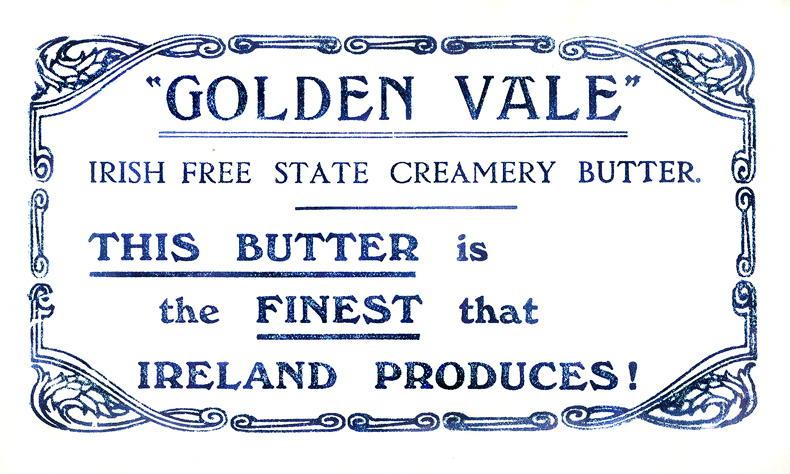
Golden Vale – probably the oldest in the Butter Museum’s collection. This Golden Vale is the probably the confederation of creameries that anticipated the later co-op of the same name.
“The museum’s current social media campaign has mined a treasure trove of existing scans of the wrappers, with resulting donations of wrappers from followers who have seen our wrappers on Twitter (@buttermuseum) and Instagram (@thebuttermuseum),” Foynes says.
“Wrappers have been found in all sorts of places; bottle stops, bookmarks and from other collectors and donors,” he adds.
Although the number of wrappers secured through the social media route has been small, the rarity of some of those located in this manner makes it all worth the effort.
“The ones that we got as a result of the social media campaign are very distinctive and I doubt we would have connected with the owners in any other way,” Foynes says.
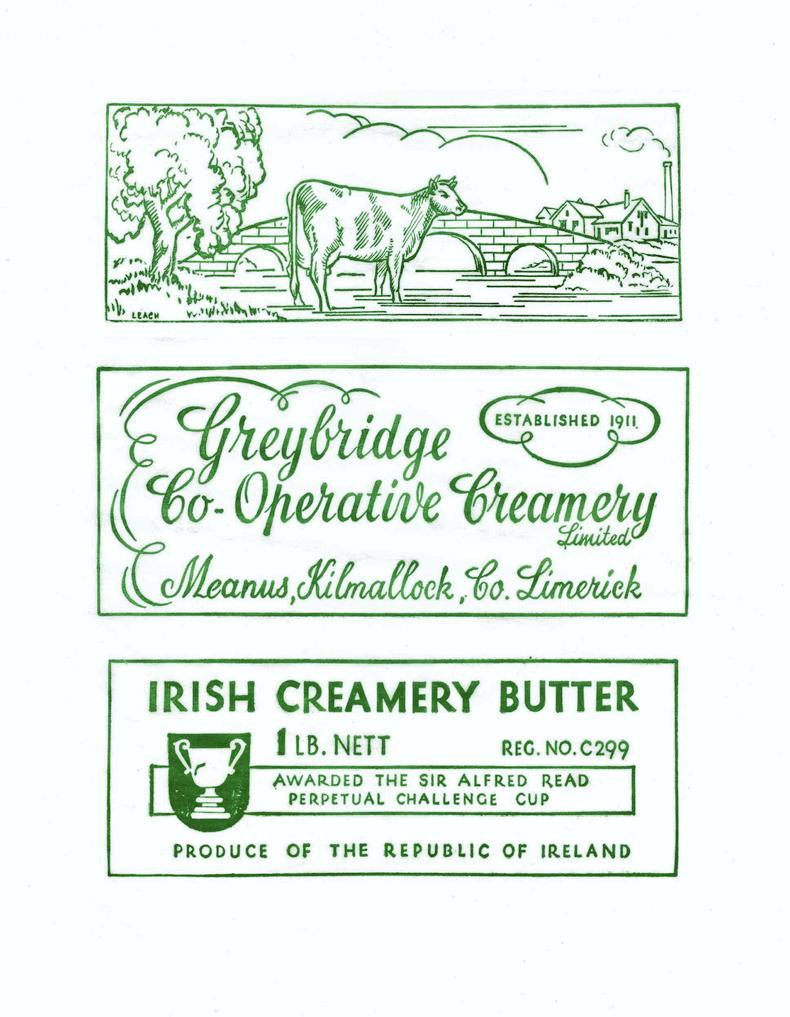
Greybridge Co-op, Meanus, Co Limerick showing an idealised version of the bridge with the creamery in the background.
As a doctored version of St Luke’s old dictum goes: “there is joy before the angels of God over every butter wrapper that is saved”.
The Butter Museum now has a total of 72 wrappers and Foynes remains focussed on expanding their collection and seeking to locate as many of the 80 or so wrappers that may still be out there in old creamery storerooms, or in the sheds or attics of those who formerly worked in the dairy industry.
“There is a preservation element to this work but the butter wrappers are also a distinctive aspect of our dairy culture and history which deserve to be celebrated and made available to a wider audience,” he insists.
Significance
Foynes maintains that the significance of the butter wrappers went well beyond their primary packaging role.
“The wrappers often proclaim the wonder of their own area or their creamery; the landscape, their modernity, their success,” he points out.

Black Abbey Co-op, Adare, Co Limerick, showing the Franciscan Abbey in the village.
“Though there are some familial relationships in the designs, each wrapper speaks of the unique creamery and the wider community that created the butter.”
This individuality of some of the designs is evident from a cursory examination of the wrappers.
For example, the wrapper from Blackabbey Creamery in Adare, Co Limerick carries a sketch of the old ruined Franciscan friary outside the village, as well as a representation of the area’s famous thatched cottages.

Rathmore, Co Kerry, happily appropriating the brand recognition of the name 'Lily of Killarney'; a Dairy Disposal Company creamery.
Borrisoleigh Co-op takes a different approach in marketing its “celebrated” Golden Valley butter. The wrapper, which carries a drawing of a horned cow, boasts that the butter is the product ?of a “super quality Irish centrifugal creamery”.
Meanwhile, the wrapper from Greybridge Co-op in Meanus, Co Limerick reminded buyers that the creamery was awarded the Sir Alfred Read Perpetual Challenge Cup by the Department of Agriculture for the quality of its butter.
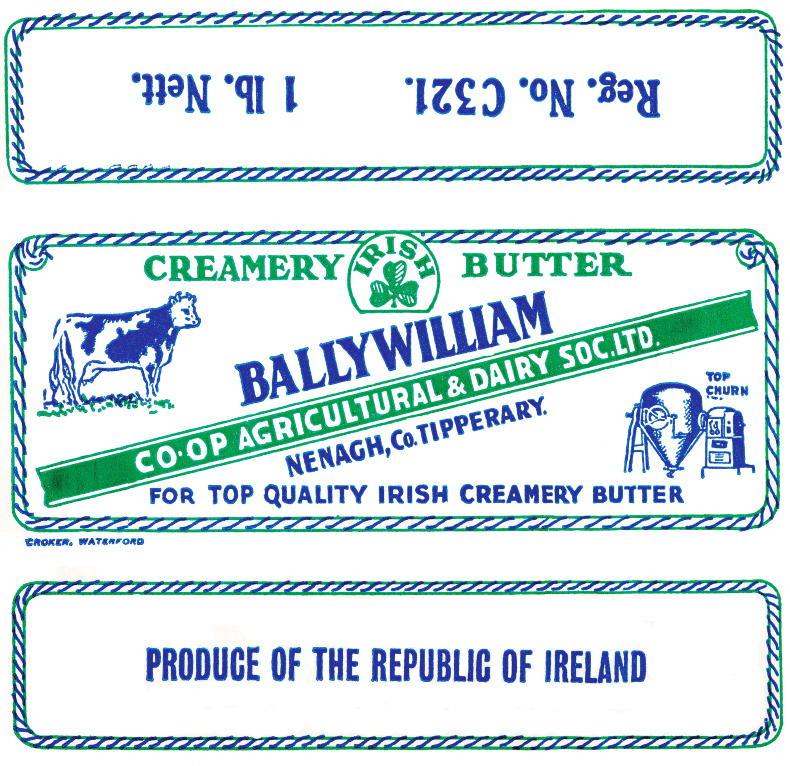
Ballywilliam, Co Tipperary; shows the modernity of the triangular stainless steel creamery butter churn, which replaced the older wooden creamery churn.
The wrappers - which were mainly printed by just two companies, Colemans of Cork and Crokers of Waterford - also carried standard information about the creamery. Each included the creamery registration number, allocated by the Department of Agriculture, while some had telephone numbers or postal addresses.
A lost Ireland
The Butter Museum believes ?as butter wrappers provide a fascinating and unique insight into how the creamery sector viewed itself and its role in an Ireland that was on the cusp of profound change ?that they merit further study from such perspectives as ?designs changed over time, and how they compared with the packaging used by British and Danish butter manufacturers.
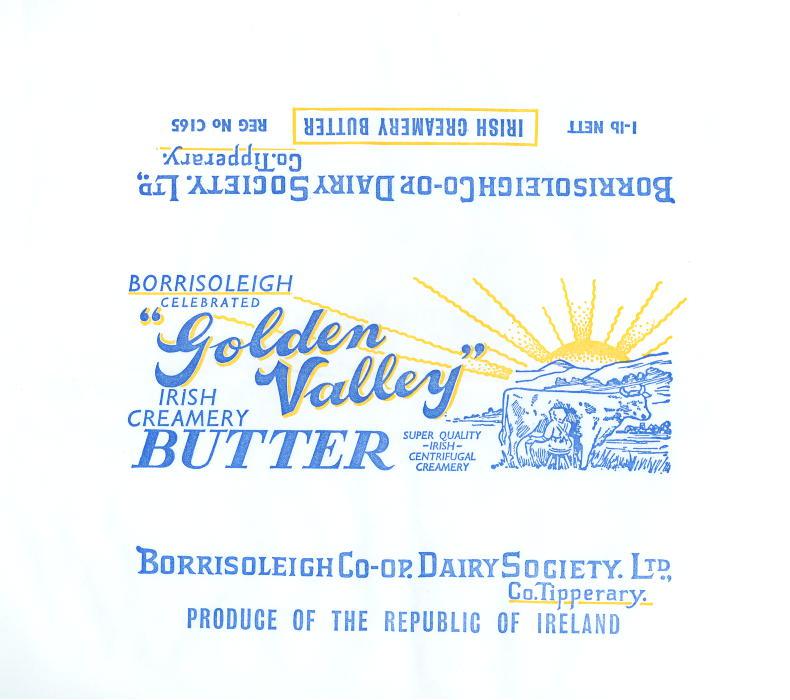
Borrisoleigh, Co Tipperary; the Slieve Felim mountains in the background. This wrapper features the traditional hand milking but celebrates the modernity of its “Super Quality Irish Centrifugal Creamery”.
First and foremost, however, Foynes recognises the intrinsic value of the wrappers beyond their importance as research props.
“Collectively, the wrappers speak of a different, now lost, rural Ireland. A country of horned cattle, the community and conviviality of the daily trip to the creamery, the locality of food production and consumption, the local rivalry of club and creamery.”
Digitising The wrappers
The Butter Museum, in collaboration with UCC, has undertaken an extensive wrapper scanning process with second year Digital Humanities students.
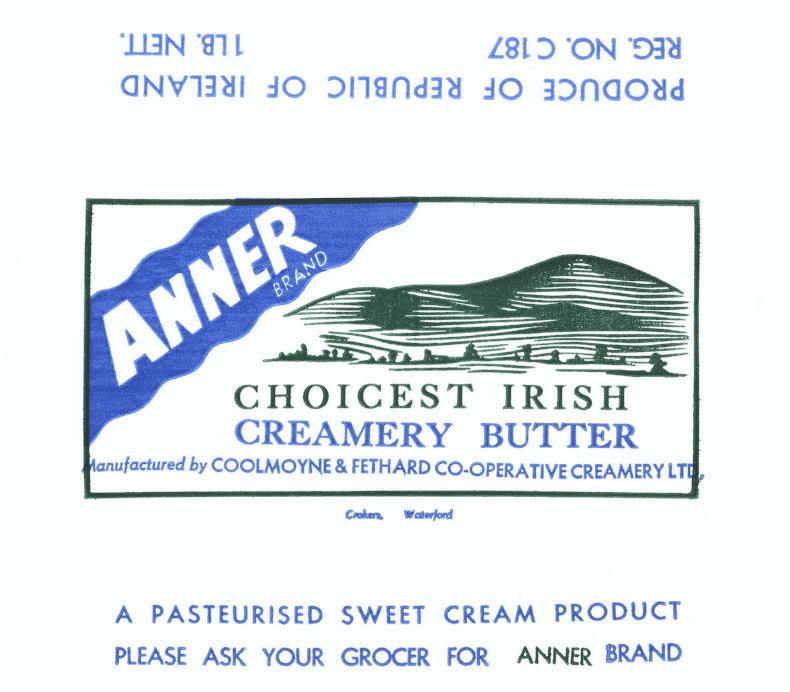
Coolmoyne and Fethard Co-op, Co Tipperary; the Anner brand takes the name of a local river and features the backdrop of Sliabh na mBan.
This scanning of over 70 wrappers will be spread out over four years, beginning this year, with the framed wrappers being removed, scanned and reframed.
“These scans will be uploaded to the Digital Repository of Ireland (DRI) for correct digital representation, and for the safeguarding of these important historical and cultural documents through active curation management,” explains Dominic Moore, who is leading the project on the Butter Museum side.
Dr James O’Sullivan of the Department of Digital Humanities in UCC says the college are delighted to be involved in the project.
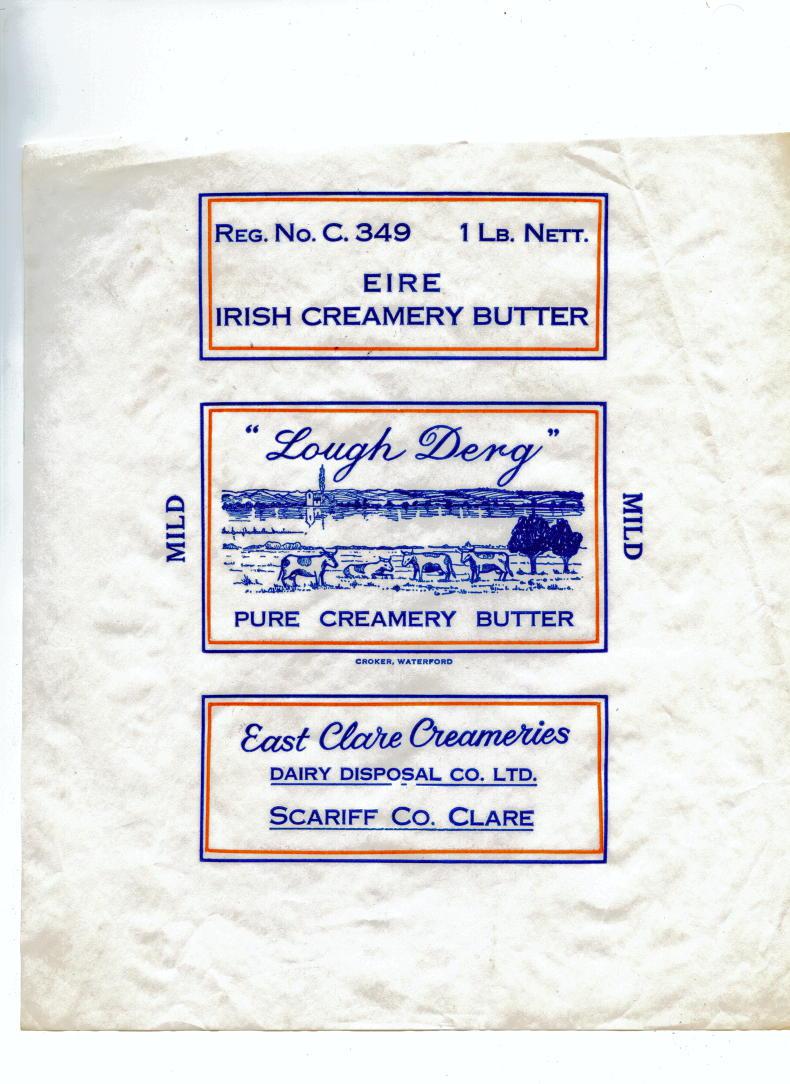
East Clare Creameries- a naïve drawing that, nonetheless, conveys the scenic beauty of Lough Derg. Three of the four creameries in Co. Clare were not co-operatives, but were owned by the Dairy Disposal Company, a semi-state company.
“Where possible, we try to get students engaged with cultural organisations, so that the skills they have to offer and the effort they expend on coursework can benefit our local community and heritage organisations in some way,” he says.
“And of course the students benefit from working with the experts at such organisations, and get some real world, practical experience. Projects like this are a great example of how the UCC curriculum is connected to Cork.”
Just seven decades ago, Ireland had more than 150 distinctive butter brands.
This is difficult to comprehend today, given the consolidated nature of the modern dairy industry and the near omnipotent presence of Kerrygold as the face of Irish butter in the global market.
However, in the years before the establishment of Bord Bainne and its subsequent launch of Kerrygold, each local creamery wrapped and sold its own butter.
In fact, the Department of Agriculture listed 157 creameries in 1955, the vast majority local co-operatives, each with its own butter brand and individual butter wrapper.
While there was very little difference in the butter produced by this network of creameries from a taste perspective, their wrappers were distinctive.

Sean Flanagan, Ballaghaderreen, Co Roscommon. This is a wrapper from a shop, not a creamery, but the creamery number, C179, is from Gurteen, Co Sligo.
Locating and saving these wrappers for posterity is the focus of a novel project involving The Butter Museum based in Cork and a team from UCC.
Using social media, the project team sought the help of the general public in an effort to source some of the old wrappers for the museum.
The project team are also digitising the collection of wrappers so that they can be viewed online.
Social media success
Peter Foynes of The Butter Museum explains that they had in excess of 65 wrappers from creameries up and down the country, but the social media campaign has extended their reach and secured wrappers which could have been lost to posterity.

Golden Vale – probably the oldest in the Butter Museum’s collection. This Golden Vale is the probably the confederation of creameries that anticipated the later co-op of the same name.
“The museum’s current social media campaign has mined a treasure trove of existing scans of the wrappers, with resulting donations of wrappers from followers who have seen our wrappers on Twitter (@buttermuseum) and Instagram (@thebuttermuseum),” Foynes says.
“Wrappers have been found in all sorts of places; bottle stops, bookmarks and from other collectors and donors,” he adds.
Although the number of wrappers secured through the social media route has been small, the rarity of some of those located in this manner makes it all worth the effort.
“The ones that we got as a result of the social media campaign are very distinctive and I doubt we would have connected with the owners in any other way,” Foynes says.

Greybridge Co-op, Meanus, Co Limerick showing an idealised version of the bridge with the creamery in the background.
As a doctored version of St Luke’s old dictum goes: “there is joy before the angels of God over every butter wrapper that is saved”.
The Butter Museum now has a total of 72 wrappers and Foynes remains focussed on expanding their collection and seeking to locate as many of the 80 or so wrappers that may still be out there in old creamery storerooms, or in the sheds or attics of those who formerly worked in the dairy industry.
“There is a preservation element to this work but the butter wrappers are also a distinctive aspect of our dairy culture and history which deserve to be celebrated and made available to a wider audience,” he insists.
Significance
Foynes maintains that the significance of the butter wrappers went well beyond their primary packaging role.
“The wrappers often proclaim the wonder of their own area or their creamery; the landscape, their modernity, their success,” he points out.

Black Abbey Co-op, Adare, Co Limerick, showing the Franciscan Abbey in the village.
“Though there are some familial relationships in the designs, each wrapper speaks of the unique creamery and the wider community that created the butter.”
This individuality of some of the designs is evident from a cursory examination of the wrappers.
For example, the wrapper from Blackabbey Creamery in Adare, Co Limerick carries a sketch of the old ruined Franciscan friary outside the village, as well as a representation of the area’s famous thatched cottages.

Rathmore, Co Kerry, happily appropriating the brand recognition of the name 'Lily of Killarney'; a Dairy Disposal Company creamery.
Borrisoleigh Co-op takes a different approach in marketing its “celebrated” Golden Valley butter. The wrapper, which carries a drawing of a horned cow, boasts that the butter is the product ?of a “super quality Irish centrifugal creamery”.
Meanwhile, the wrapper from Greybridge Co-op in Meanus, Co Limerick reminded buyers that the creamery was awarded the Sir Alfred Read Perpetual Challenge Cup by the Department of Agriculture for the quality of its butter.

Ballywilliam, Co Tipperary; shows the modernity of the triangular stainless steel creamery butter churn, which replaced the older wooden creamery churn.
The wrappers - which were mainly printed by just two companies, Colemans of Cork and Crokers of Waterford - also carried standard information about the creamery. Each included the creamery registration number, allocated by the Department of Agriculture, while some had telephone numbers or postal addresses.
A lost Ireland
The Butter Museum believes ?as butter wrappers provide a fascinating and unique insight into how the creamery sector viewed itself and its role in an Ireland that was on the cusp of profound change ?that they merit further study from such perspectives as ?designs changed over time, and how they compared with the packaging used by British and Danish butter manufacturers.

Borrisoleigh, Co Tipperary; the Slieve Felim mountains in the background. This wrapper features the traditional hand milking but celebrates the modernity of its “Super Quality Irish Centrifugal Creamery”.
First and foremost, however, Foynes recognises the intrinsic value of the wrappers beyond their importance as research props.
“Collectively, the wrappers speak of a different, now lost, rural Ireland. A country of horned cattle, the community and conviviality of the daily trip to the creamery, the locality of food production and consumption, the local rivalry of club and creamery.”
Digitising The wrappers
The Butter Museum, in collaboration with UCC, has undertaken an extensive wrapper scanning process with second year Digital Humanities students.

Coolmoyne and Fethard Co-op, Co Tipperary; the Anner brand takes the name of a local river and features the backdrop of Sliabh na mBan.
This scanning of over 70 wrappers will be spread out over four years, beginning this year, with the framed wrappers being removed, scanned and reframed.
“These scans will be uploaded to the Digital Repository of Ireland (DRI) for correct digital representation, and for the safeguarding of these important historical and cultural documents through active curation management,” explains Dominic Moore, who is leading the project on the Butter Museum side.
Dr James O’Sullivan of the Department of Digital Humanities in UCC says the college are delighted to be involved in the project.

East Clare Creameries- a naïve drawing that, nonetheless, conveys the scenic beauty of Lough Derg. Three of the four creameries in Co. Clare were not co-operatives, but were owned by the Dairy Disposal Company, a semi-state company.
“Where possible, we try to get students engaged with cultural organisations, so that the skills they have to offer and the effort they expend on coursework can benefit our local community and heritage organisations in some way,” he says.
“And of course the students benefit from working with the experts at such organisations, and get some real world, practical experience. Projects like this are a great example of how the UCC curriculum is connected to Cork.”













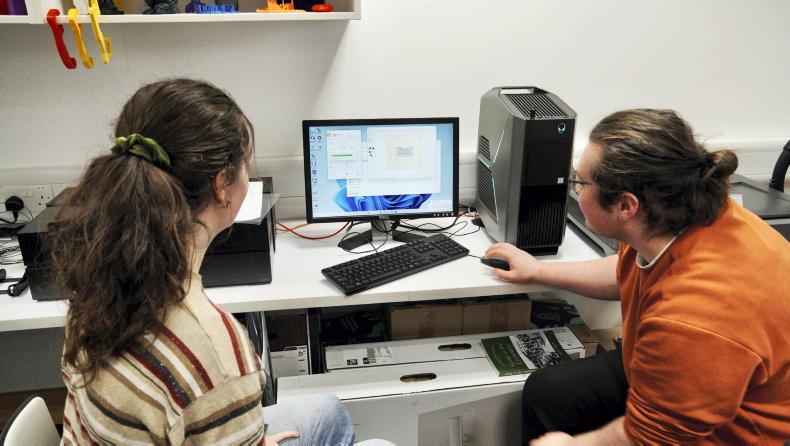
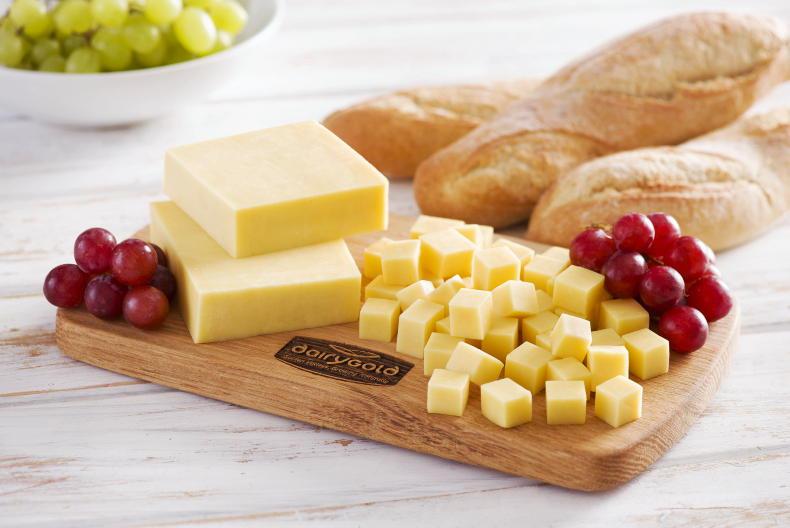

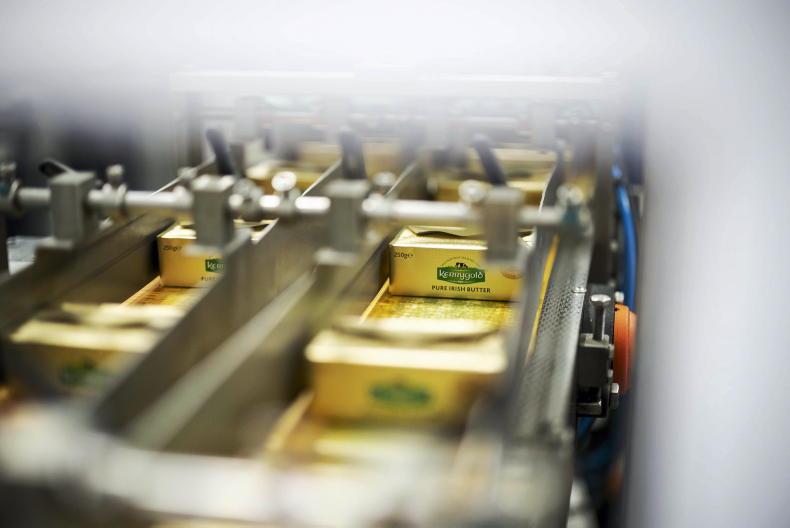
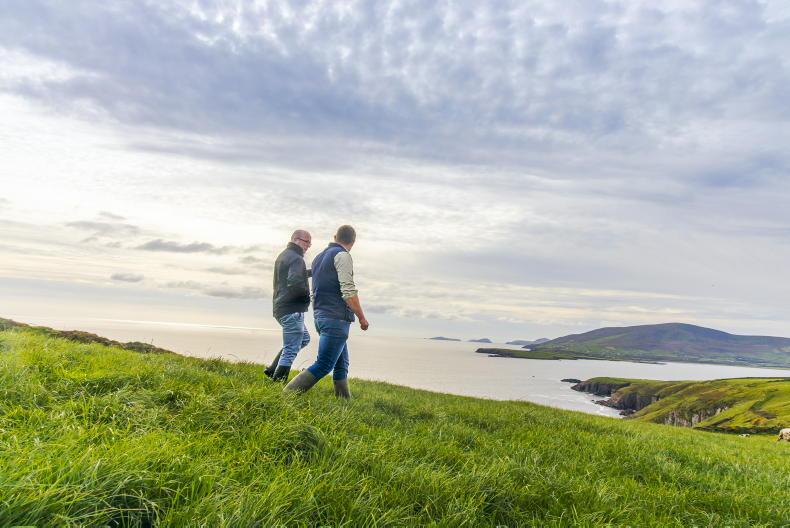
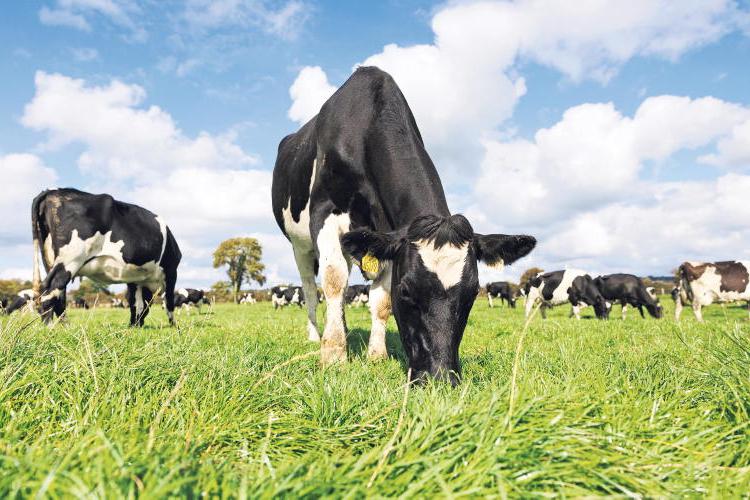
SHARING OPTIONS